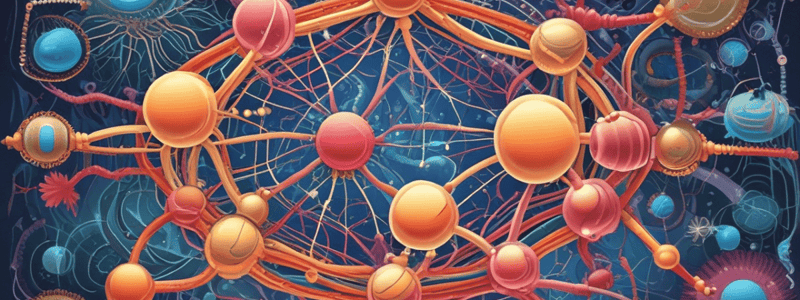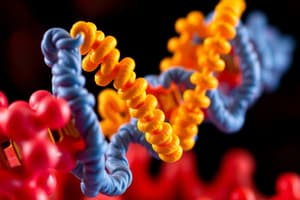Podcast
Questions and Answers
What is the energy yield from the electron transport chain for 1 NADH?
What is the energy yield from the electron transport chain for 1 NADH?
- 2.5 ATP (correct)
- 4.5 ATP
- 3.5 ATP
- 1.5 ATP
The reaction ADP + Pi => ATP + H2O is irreversible in the enzyme surface.
The reaction ADP + Pi => ATP + H2O is irreversible in the enzyme surface.
False (B)
What is the binding energy that drives the equilibrium toward the formation of ATP in the ATP synthase enzyme?
What is the binding energy that drives the equilibrium toward the formation of ATP in the ATP synthase enzyme?
The binding energy of ATP synthase stabilized ATP relative to ADP + Pi by binding ATP more tightly (Kd 10^-12 : 10^-5)
The β subunits of ATP synthase are found in the _______________________ of ATP synthase.
The β subunits of ATP synthase are found in the _______________________ of ATP synthase.
Match the following components of ATP synthase with their functions:
Match the following components of ATP synthase with their functions:
The proton gradient releases ATP from the enzyme to the solution.
The proton gradient releases ATP from the enzyme to the solution.
What is the major energy barrier in the reaction catalyzed by ATP synthase?
What is the major energy barrier in the reaction catalyzed by ATP synthase?
What is the role of the proton gradient in ATP production?
What is the role of the proton gradient in ATP production?
What is the result of proton pumping during the electron transport chain?
What is the result of proton pumping during the electron transport chain?
The energy stored in the proton-motive force is used to directly react ADP + Pi to ATP.
The energy stored in the proton-motive force is used to directly react ADP + Pi to ATP.
What is the proton-motive force (PMF)?
What is the proton-motive force (PMF)?
The energy of electron transfer is efficiently conserved in a _______________ gradient.
The energy of electron transfer is efficiently conserved in a _______________ gradient.
What is the role of ATP synthase in ATP synthesis?
What is the role of ATP synthase in ATP synthesis?
The electron transport chain and ATP synthesis are decoupled processes.
The electron transport chain and ATP synthesis are decoupled processes.
Match the components of the proton-motive force (PMF) with their descriptions:
Match the components of the proton-motive force (PMF) with their descriptions:
What is the net result of proton pumping during the electron transport chain in terms of proton movement?
What is the net result of proton pumping during the electron transport chain in terms of proton movement?
Flashcards are hidden until you start studying
Study Notes
ATP Synthesis
- ATP synthesis occurs in the β subunits of ATP synthase (F1 head group)
- The reaction ADP + Pi => ATP + H2O is reversible with a free energy change of 0
- ATP synthase stabilizes ATP relative to ADP + Pi by binding ATP more tightly (Kd 10^(-12) : 10^(-5))
- The binding energy drives the equilibrium toward ATP formation
- The proton gradient releases ATP from the enzyme
Proton Gradient and Electron Flow
- The energy of electron transfer is efficiently conserved in a proton gradient (proton motive force, PMF)
- From 1 NADH oxidized, 10 H+ are pumped plus removing 2H+ from the matrix into water
- As electrons flow between carriers, H+ are pumped out of the mitochondrial matrix
- The matrix becomes more basic and negatively charged, while the intermembrane space becomes more acidic and positively charged
Proton Motive Force (PMF)
- The proton motive force is a "battery" storing energy for eventual ATP synthesis
- The energy stored in the gradient has two components: chemical potential energy and electrical potential energy
ATP Yield from Complete Oxidation of Glucose
- 1 NADH produces 2.5 ATP
- 1 FADH2 produces 1.5 ATP
- Total ATP yield from complete oxidation of glucose: 36-38 ATP
Studying That Suits You
Use AI to generate personalized quizzes and flashcards to suit your learning preferences.




